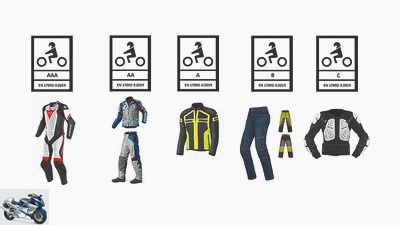Table of contents
- Certified motorcycle clothing Five new protection standards
- Comment on the new clothing standard
- opinion poll

IVM.
clothing
Certified motorcycle clothing: five new protection standards
Certified motorcycle clothing
Five new protection standards
Motorcycle clothing has recently been certified according to five new protection standards. We reveal what’s behind it and what to look out for when buying new clothing.
Michael Schumann,
Tobias Beyl
01/20/2020
The labels shown above have been used in high-quality motorcycle clothing for a long time, but the five new protection standards have only been in force for a few weeks. With the help of the five classes, represented by the letters AAA, AA, A, B and C, buyers can get a quick overview of what the clothes can do: C stands for pure impact protection, B for pure abrasion protection and A for both together – tested and certified according to the Euro standard EN 17092-2 (up to 6): 2020. When it comes to combined abrasion / impact protection, class A is practically the leisure wear that offers the highest level of comfort, but also the lowest level of protection. In the case of classes AA and AAA, the ratio is reversed accordingly, from the protector-proven touring textile suit to the pure protector racing suit.
Comment on the new clothing standard

Michael Orth.
Tobias Beyl, MOTORRAD editor at the Service Resort.
Tobias Beyl, MOTORRAD editor from the Service Resort, on the new clothing standard and what will actually change for buyers of new products.
Some people will be slightly annoyed by the increasing standardization and react to the new security standards and may say: “Typically Germany.” But firstly, the new Euro standard 17092 also applies far beyond Germany, and secondly, it affects us motorcyclists in Germany relatively little. Because when driving a motorcycle in this country, only a suitable protective helmet is mandatory, and this has long been subject to its own standard, ECE 22/05. In some other countries, however, the police also pay attention to the wearing of certified protective clothing, which is why the new standard appears more relevant there.
At the same time, that doesn’t mean that we don’t need to be interested in EN 17092! Because those who care about their own health pay attention to appropriate protective clothing. And here the five clearly distinguishable protection classes now offer a good orientation. In the best case scenario, a small motorcyclist symbol has previously certified approval as personal protective equipment, but in comparison, the new regulation makes it much easier to select the individually appropriate level of protection from a short-time-to-the-ice cream parlor to the brisk country road lap up to the race weekend.
In the meantime, of course, nobody is forced to do this, at least not among motorcyclists. The situation is different for dealers and manufacturers who are now only allowed to offer protective clothing certified according to EN 17092 as motorcycle clothing. Until now, CE marking was sufficient to allow goods to be put into circulation. This was also used by dubious suppliers from the Far East, who simply called the CE mark “China export” reinterpreted and printed their own CE mark on the goods, which could hardly be distinguished from European ones. This is made more difficult with the new regulation.
opinion poll
How do you feel about protective clothing?
Voted 2960 times
I always drive with full protective clothing – depending on the occasion (trip or fair weather trip) in a textile or leather suit.
I’m not so strict about it; when the weather is good, my helmet is enough for me.
Everything except shorts is ok on day tours.
I ride in jeans – motorcycle jeans, after all.
For me, full protective equipment also includes a safety vest.
Related articles
-
Cheapest motorcycle clothing in the test
Artist clothing Station wagons, jackets & pants Cheapest motorcycle clothing in the test Cheapest motorcycle clothing in the test Attractants Discounters…
-
Test motorcycle clothing for beginners
clothing Test motorcycle clothing for beginners Motorcycle clothing for beginners 5 complete outfits in the test Jeans, leather or textile, full-face,…
-
Spidi J-Tracker Tech: Biker jeans protection class AA
Spidi clothing Station wagons, jackets & pants Spidi J-Tracker Tech: Biker jeans protection class AA Spidi J-Tracker Tech Protection class AA motorcycle…
-
Winter motorcycle clothing for cold days
Schmid 9 pictures MPS studio 1/9 Thermoboy 365+: 59.90 euros, MOTORRAD verdict: satisfactory. MPS studio 2/9 BMW PCM undersuit: 240 euros, MOTORRAD…
-
Podcast: Motorcycle clothing for women
Ferdinand Heinrich-Steige clothing Clothing guide Podcast: Motorcycle clothing for women Podcast MOTORRAD driver episode 6 Motorcycle clothing for women…
-
Lights on motorcycle clothing and helmets
manufacturer 13th pictures manufacturer 1/13 The retrofittable Held Light System (HLS) is the latest development from Held. The LED modules light up…
-
Clothing from the motorcycle manufacturer
Bilski clothing Station wagons, jackets & pants Clothing from the motorcycle manufacturer Clothing from the motorcycle manufacturer Factory driver The…
-
clothing Clothing guide Clothing guide Buy with brains You buy what you like. This also applies to motorcycle clothing. MOTORRAD shows which…
-
Buying advice motorcycle clothing for women
mps photo studio 24 pictures www.factstudio.de 1/24 Functional underwear from the left: Germot F-Lite Megalight, Primero Polar, Rukka Mona, Dainese…
-
Retrofit protectors for motorcycle clothing in the test
Drawing: Aue clothing Retrofit protectors for motorcycle clothing being tested Product test retrofit protectors Which retrofit protectors are safe??…